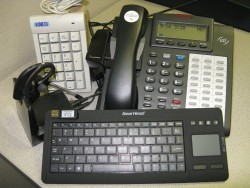After an injury, recovery, and rehabilitation, a thirty-something North Dakotan was ready to return to work. She was now using a chair for mobility and had limited use of her arms and hands, so she knew she would need help to re-enter the workforce. That is when she connected with North Dakota Vocational Rehabilitation Services, and with her counselor identified an employment goal, and the steps to achieving it. One of the steps was to have an assistive technology (AT) assessment, and I was fortunate enough to be the assessor.
The assessment was one that as an ATP, I dream about. The request was for AT devices specific to a job she had done previously, so she was knowledgeable about what needed to be done differently, and was willing and excited to try new ways of doing things. We looked at three work tasks that were now going to require accommodations; phone use, computer use, and paper-handling. I asked her do these work activities without AT, and then talked to her about AT devices I thought would make doing her job independently possible. Given the choice to try out various AT devices, she opted to try everything offered.
 After exploring her choices, we settled on: 1) an over the ear wireless headset and automated handset lifter to address her need for hands-free phone use; 2) a smaller keyboard with built-in track pad, a stand-alone numeric keypad plus stand to address her need to type with only a few fingers of one hand and mouse with only the thumb of the other; and 3) rubber finger pads to provide the grip needed to turn pages or stack and turn paper over.
After exploring her choices, we settled on: 1) an over the ear wireless headset and automated handset lifter to address her need for hands-free phone use; 2) a smaller keyboard with built-in track pad, a stand-alone numeric keypad plus stand to address her need to type with only a few fingers of one hand and mouse with only the thumb of the other; and 3) rubber finger pads to provide the grip needed to turn pages or stack and turn paper over.
She left ready to tackle her old job with new tools, and with a sense of purpose.
If you are looking to do a work task differently due to disability or aging, remember one of IPAT’s fee based services is to provide AT assessments, check it out.
